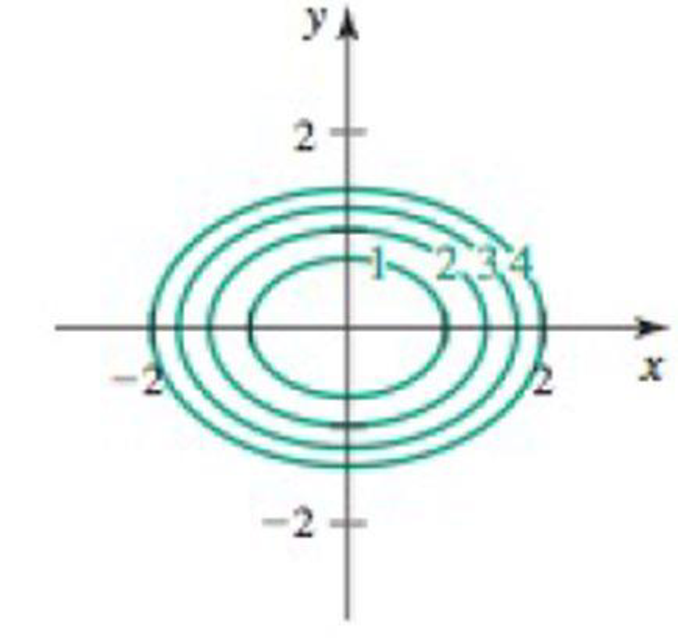
Concept explainers
Equipotential curves Consider the following potential functions and graphs of their equipotential curves.
a. Find the associated gradient field F = ▿ϕ.
b. Show that the vector field is orthogonal to the equipotential curve at the point (1, 1). Illustrate this result on the figure.
c. Show that the vector field is orthogonal to the equipotential curve at all points (x, y).
d. Sketch two flow curves representing F that are everywhere orthogonal to the equipotential curves.
40. ϕ (x, y) = x2+ 2y2

Want to see the full answer?
Check out a sample textbook solution
Chapter 17 Solutions
CALCULUS: EARLY TRANSCENDENTALS (LCPO)
Additional Math Textbook Solutions
A Problem Solving Approach To Mathematics For Elementary School Teachers (13th Edition)
Elementary Statistics (13th Edition)
Elementary Statistics: Picturing the World (7th Edition)
A First Course in Probability (10th Edition)
University Calculus: Early Transcendentals (4th Edition)
College Algebra (7th Edition)
- Plz solve part carrow_forwardFind the gradient fields ƒ(x, y, z) = (x raise to the power 2 + y raise to the power 2 + z raise to the power 2)-1>2arrow_forwardA net is dipped in a river. Determine the flow rate of water across the net if the velocity vector field for the river is given by v = (x - y, z + y +7,z²) and the net is decribed by the equation y = √1-x²-2², y 20, and oriented in the positive y-direction. (Use symbolic notation and fractions where needed.) 1.45-1 yasarrow_forward
- The vector function r(t) is the position of a particle in space at time t. Determine the graph of the position function. r(t) = (3t cos t)i + (3t sin t)j + 2tkarrow_forwardFourier's Law of heat transfer (or heat conduction) states that the heat flow vector F at a point is proportional to the negative gradient of the temperature: that is, F= -kVT, which means that heat energy flows from hot regions to cold regions. The constant k is called the conductivity, which has metric units of J/m-s-K or W/m-K. A temperature function T for a region D is given below. Find the net outward heat flux SSF•nds= - kff triple integral. Assume that k = 1. T(x,y,z)=110e-x²-y²-2². D is the sphere of radius a centered at the origin. The net outward heat flux across the boundary is. (Type an exact answer, using as needed.) G S VT.n dS across the boundary S of D. It may be easier to use the Divergence Theorem and evaluate aarrow_forward7. Properties of position vectors Let r = xi + yj + zk and let r = |r|. a. Show that Vr = r/r. b. Show that V(r") = nr"-2r. c. Find a function whose gradient equals r.arrow_forward
- a. Sketch the graph of r(t) = ti+t2j. Show that r(t) is a smooth vector-valued function but the change of parameter t = 73 produces a vector-valued function that is not smooth, yet has the same graph as r(t). b. Examine how the two vector-valued functions are traced, and see if you can explain what causes the problem.arrow_forwardEasy Calculus, please solve. I will rate and like. Thank you.arrow_forwardRepresent the curve by a vector-valued function r(t) using the given parameter.arrow_forward
- Sketch the plane curve represented by the vector-valued function and give the orientation of the curve. r(t) = i + (t− 1)j eBook -10 -10 O -5 -5 y 10 5 -fol y 10 5 -105 5 5 10 X X 10 -10 -10 -5 -5 y 10 5 -fol y 10 5 -104 5 5 X 10 X 10arrow_forwardFourier's Law of heat transfer (or heat conduction) states that the heat flow vector F at a point is proportional to the negative gradient of the temperature: that is, F = -kVT, which means that heat energy flows from hot regions to cold regions. The constant k is called FondSk the conductivity, which has metric units of J/m-s-K or W/m-K. A temperature function T for a region D is given below. Find the net outward heat fluxarrow_forwardplease send correct answerarrow_forwardarrow_back_iosSEE MORE QUESTIONSarrow_forward_ios
- Algebra & Trigonometry with Analytic GeometryAlgebraISBN:9781133382119Author:SwokowskiPublisher:Cengage
 Algebra and Trigonometry (MindTap Course List)AlgebraISBN:9781305071742Author:James Stewart, Lothar Redlin, Saleem WatsonPublisher:Cengage Learning
Algebra and Trigonometry (MindTap Course List)AlgebraISBN:9781305071742Author:James Stewart, Lothar Redlin, Saleem WatsonPublisher:Cengage Learning

